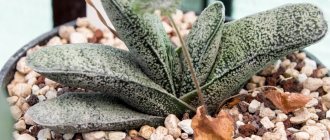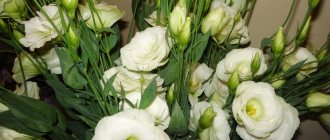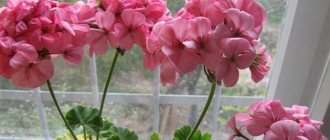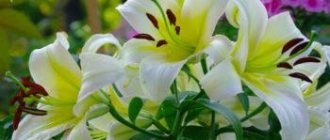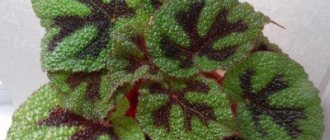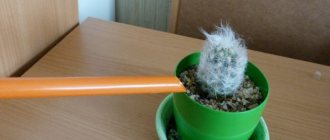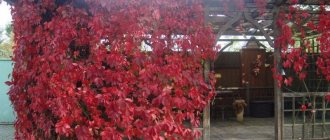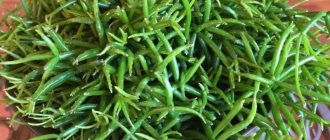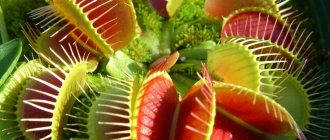Calibrachoa
Calibrachoa has significant external similarities to petunia, but they are different plants with different DNA structures. Calibrachoa is distinguished by a large number of small flowers with a “throat” of brown or yellow shades. The stem is branched, strong, with short hairs, early woody. The leaves are small and covered with hairs. Plant of ampelous type.
The following varieties have been developed by breeders:
- "Coral pink";
- "Kalita snow-white";
- "Cherry Star";
- "Apricot Punch";
- "Pink Chiffon";
- "Grape Punch"
Learn more about how to plant and grow Calibrachoa flowers.
What is the difference between calibrachoa and petunia?
Sometimes calibrachoas are sold in garden centers under the name “ampel petunia”, “surfinia”, or something like that. There is no point in blaming the manufacturers for this. These names are aimed at consumers who do not know about calibrachoa, but are already informed about surfinia.
If you are also faced with this situation, have never seen calibrachoa, and it seems to you that the “surfinia” sold is exactly it, do the following:
- look at the size of the flower - it was already written above that in Calibrachoa it is no more than 3 cm. But this is an indirect “evidence”, because in minitunia (Shock Wave), the flower is also not large;
- direct your attention to the pharynx (“throat”) at the base of the corolla. The pharynx differs sharply in color; as a rule, it is bright yellow; - look at the leaves - this is probably the most direct and obvious difference between calibrachoa and petunia
Calibrachoa leaves are small (width no more than 1 cm, length - 4 cm), elongated, covered with short hairs. There is the same fluff on the stems;
- look at the leaves - this is probably the most direct and obvious difference between calibrachoa and petunia. Calibrachoa leaves are small (width no more than 1 cm, length - 4 cm), elongated, covered with short hairs. There is the same fluff on the stems;
- look at the stem. The stem of Calibrachoa is dense, prone to lignification. In petunia it is herbaceous and flexible, in calibrachoa it looks like the trunk of a bush.
Minitunia
Minitunia is similar to petunia, only the small tiny flowers are so tiny that they cannot be confused with anything else. The plant is not tall, grows strongly and branches, forms strong shoots that are resistant to brittleness. Due to the abundance of buds forming on one bush, it resembles a colored cloud. Used in hanging flowerpots, as a groundcover and border plant.
[adsp-pro-4]
The most popular varieties:
- "Rose";
- "Rose Vane";
- "Blue Storm";
- "Ivory";
- "Coral Crash".
Reproduction
In addition to propagation by seeds, there is a more reliable and simpler method - cuttings.
The reproduction process has its own characteristics:
- Harvesting cuttings occurs from February to May.
- Cuttings can be carried out throughout the year.
- Cut planting material from the tops of the shoots. Leave 4-6 leaves on the cut cuttings, of which leave only the top 2, shortened by half.
- Treat the cut part of the cutting with a solution that stimulates the growth of the root system. Place it in soil that is similar in composition to the soil mixtures used for sowing seeds. Deepen the cutting to ¼ of its length.
- A gap of 15-20 cm should be maintained between seedlings.
- After planting, sprinkle the cuttings with soil or perlite. The layer thickness is 20-25 mm, and then treated with an antifungal agent.
- Cover the box with seedlings with film and take it to a well-lit room. The temperature there should be 21-24 degrees Celsius.
Reproduction and cultivation of petunia by cuttings.
Petunia comes not only as a bush petunia, but also in other types, for example, low-growing and vegetative. In general, this plant is famous for its large number of varieties, which we talk about in our articles. We invite you to get acquainted with such beautiful petunias as Ramblin, Typhoon Silver, Wave, Starry Sky, Opera, Surfinia, Tidal.
Mirabilis
A plant of the Nyctaginaceae family called Mirabilis is a branching bush with ovate-elongated paired leaves. It has a unique feature - flowers of different colors may appear on one seedling, which bloom at night and fade by morning.
The flowers are fragrant, solitary, varied in color: from pastel to bright, one-, two- or three-color. The uniqueness of the flower is the absence of a corolla. The plant prefers sunlight and windless areas, fertile soil.
Of the 60 species, the Mexican mirabilis jalapa is widespread, several of its varieties are:
- "Iolanta";
- "Elvira";
- "Red Lollipop";
- "Mirabilis Serenade";
- "Mirabilis marble."
Read how to grow a Mirabilis plant in open ground.
Growing and caring for calibrachoa
Calibrachoa requires plenty of heat and light to grow well. Sunny terraces or balconies facing southeast or south are very good for Calibrachoa. But without the drying heat. In aggressive midday sun, the plant can burn - you need to shade it during these hours.
Calibrachoa also does not like strong winds, which can ruffle and tear stems and flowers. An open balcony on the top floor of a high-rise building is not the best place for a plant. It is best to grow calibrachoa in a place protected from the winds.
Calibrachoa is planted in balcony boxes, flowerpots, and hanging baskets. One plant will require at least 3 liters of soil. The substrate should be light, preferably with a large amount of disintegrants.
Calibrachoa is much smaller and needs moist soil than petunia. On the contrary, moisture is unacceptable. Calibrachoa is easy to overwater, causing its tender roots to rot and the plant itself to die. But calibrachoa loves constant spraying. On hot days, do not be stingy with water and spray calibrachoa 3 times a day.
Throughout the growing season, caring for calibrachoa involves intensive feeding. Be sure to apply fertilizer once a week. When calibrachoa budding and flowering, use formulations with a high content of potassium and phosphorus.
For constant flowering, faded flowers need to be picked off to prevent seeds from setting. In the second half of summer, when flowering becomes weaker, you can prune the stems. This will be a good stimulation for branching and formation of young buds.
Surfinia
The effectiveness of this hanging plant, which is considered a petunia hybrid, amazes many gardeners. Long, powerful stems and abundant flowering are the distinctive characteristics of surfinia.
[adsp-pro-5]
The color range is represented by a wide palette from white to purple. The flowers are bright and form a blooming ball. Today there are more than 20 varieties of surfinia.
Particularly popular:
- "Hot Pink";
- "Table White";
- "Yelou";
- "Giant Parple";
- "Surfinia Red".
We offer you to read an article about the care and cultivation of the Surfinia hybrid.
Description of the structure of the plant
Let's see how a flower is structured, what kind of leaves it has - simple or complex, how the buds differ.
- Petunia leaves - the leaf of Petunia is simple, green or dark green in color, slightly pubescent, can be small or large (depending on the variety). The leaves are located on the stem one after another on a small stalk or without it at all, that is, sessile.
- Petunia flowers - the flower is a corolla of five petals (fused), which stands on a calyx of five sepals (heavily pubescent), flowers can be simple or double, large, single, issued from the axils of the leaves on short pedicels, shaped like a funnel , anthers paired, elongated. There are all colors - from white to black, the duration of flowering of one flower is 5 days.
- Petunia bud - the bud on the plant forms and opens within a week; it has an elongated, elongated shape.
- Roots - the root system of the plant is very well developed, powerful, tap-type with a large number of adventitious roots, so if you want to grow this flower on your balcony, you will need a fairly capacious container for soil. For example, only two plants can be planted in a 1 meter long flower box, otherwise their development and flowering will be greatly hampered.
- Petunia inflorescence can be a single color, as well as with a variety of patterns - stars, specks, dashes, a border of a different color, even a double color.
morning glory
Morning glory is a genus of plants in the bindweed family. Poisonous climbing vine (up to 5 meters) with heart-shaped leaves, large funnel-shaped flowers of various shades. Morning glory gramophone flowers vaguely resemble petunia. The most common genus is the sweet potato morning glory, which includes five hundred species.
Of the 500, twenty-five are used in floriculture, the most popular of which are:
- "Ipomoea Cairo";
- "Ipomoea sky blue";
- "Ipomoea purpurea";
- "Ipomoea Nile";
- "Ipomoea moonflower."
Find out more about growing perennial Morning Glory outdoors.
Features of reproduction
You need to remove petunia from the garden and plant it in a pot in the fall. After a certain time necessary for them to rest, the plants can bloom again. Petunia is also propagated by cuttings. This is more relevant for hybrids, since it is impossible to get seeds from them.
- For cuttings, remove the necessary specimens from the garden, and then put them in a cool place for storage for the winter.
- In March, take cuttings from the plant.
- Remove the lower leaves, leaving only 2-3 pairs at the top.
- Before planting, place the cuttings in Kornevin for a few minutes.
- Place the cuttings in water for rooting, or you can immediately stick them into light soil and cover with polyethylene.
- As soon as new leaves begin to form, remove the polyethylene so that the plant gradually gets used to the microclimate.
- After just a week, remove the covering material completely.
Datura
Datura is a genus of plants in the nightshade family. An annual plant with a bare erect stem, about 1 meter high, forms a bright bush with huge gramophone flowers.
Datura leaves differ from petunia leaves in that they have dark green and lighter shades. The flowers are solitary, large, located in the forks of the stem. The flower is unpretentious, but responds gratefully with abundant flowering on fertile soil.
Attention. Datura is a poisonous plant that can intoxicate. Symptoms of poisoning may occur with prolonged close contact.
Varieties that are relevant to gardeners:
- "Common Datura";
- "Indian Datura";
- "Brugmansia";
- "Datura blizzard."
Read about how to grow dope from seeds in your garden.
Fuchsia ampelous
A very beautiful plant with unusual flowers of different colors. It blooms for an indecently long time - from May to October.
Fuchsia also has certain nuances in care:
- the top layer of soil should not dry out;
- loves partial shade;
- pruning is necessary - in the spring, to give the plant its shape, its stems are shortened by one third, and during the season the shoots are pinched to make the bush more luxuriant;
- responsive to fertilizing with any fertilizer for flowering plants.
From September, feeding is stopped and the plant is prepared for winter rest.
Fuchsia is most easily propagated using cuttings.
Lavatera
Delicate pink, white and purple flowers with a silky tint make it difficult to confuse Lavatera with any other garden plant, even petunia. These are malt varieties. The leaves are spade, have hairs, the flowers are large, the buds create spikelet inflorescences.
[adsp-pro-6]
Has a long flowering period. The whole advantage of this flower is that it is not picky about the soil and is resistant to drought and wind.
Florists use two types:
- Lavatera annual (Silver Cap, Mont Blanc, Lovelines, Pink Beauty, Ruby Queen).
- Lavatera perennial (Lilak, Lady Bregon, Springs, Burgundy Vine, IKatcher).
We invite you to read an article about how to grow Lavatera from seeds on your own plot.
Impeller balsam
People call him Vanka wet and Ogonyok. It has a huge hat of white, pink or red flowers. Blooms from June until the first frost. If the plant is moved indoors in winter, it will continue to bloom.
Balsam. (Photo used under standard license ©ogorodnye-shpargalki.ru)
Prefers partial shade.
Propagated by seeds and cuttings.
Advice!
In order for the flower to bloom magnificently, plant it in a small pot. If the pot is too small for him, then there will be little greenery, but a lot of flowers. In the big one it’s the other way around.
During flowering, balsam requires additional feeding once every two weeks in the form of fertilizer for flowering plants.
The most vulnerable point in caring for it is watering. The moisture of the soil must be regularly monitored and not allowed to dry out. In too dry weather it is recommended to spray the plant.
Brugmansia
Brugmansia is a genus of plants from the nightshade family. In summer it is covered with an abundance of flowers, which are called “angel trumpets”.
Attention! This is a poisonous shrub. The abundance and intensity of its aroma causes headaches, and toxic substances cause hallucinations.
Stems are woody, covered with smooth bark. The main asset of the plant is its spectacular flowers. The petals can be of various shades: white, cream, scarlet, yellow, blue.
Popular varieties:
- "Fragrant Brugmansia";
- "Golden";
- "Snow White";
- "Bloody";
- "Colorful Brugmansia"
Read about growing Brugmansia in open ground.
Decorative and ordinary dwarf varieties.
Dwarfs appeared not so long ago, but are already popular among most gardeners. The bushes of these petunias are dense, ball-shaped, grow up to 0.15-0.25 m, and are almost completely covered with many small, 2-4 cm in size, rich flowers. Petunias bloom for a long time, in large quantities, so the flowers are beautiful throughout the summer season. The variety is resistant to bad weather and precipitation. Since dwarfs love light, they are planted in a well-lit open area with a lot of sun. Plants begin to bloom 60-70 days after the seeds are sown. Dwarfs are planted in groups, create a background for single plants, and decorate flower beds and borders.
Variety "Fantasy". A dense bush in the shape of a ball, its diameter is 25 cm. Small, smooth flowers are painted in one tone: white, pink, red, purple, or have a rich center and veins. Plants bloom in large numbers before the onset of frost. The variety is resistant to bad weather. Petunias are used to create rich borders, they become an excellent decoration for flower beds, and are also planted in containers.
Variety "Limbo". The bushes are small, dense, branch well, grow up to 0.15-0.2 m, but the flowers cover them with very large ones, up to 12 cm in size. The flowers are not subject to stretching when cultivated in the open air. Plants bloom in large numbers and for quite a long time. The flowers are painted in various colors. Petunias are weather-resistant and recover quickly from rainy days. They begin to bloom faster compared to other flowers of this variety. These flowers are used to decorate flower beds, flower beds, borders and borders.
Fragrant tobacco
Tobacco is a genus of perennial and annual plants of the nightshade family. The bush is erect, branched, the leaves are large, dark green. The flowers are funnel-shaped, large, white, yellow or green, open in the absence of sun.
The flower prefers fertilized soils well supplied with moisture. Resistant to pests and diseases, able to repel pests from plants adjacent to the garden.
Many varieties have been developed that have a wide variety of colors:
- "Pink";
- "Raspberry red";
- "Lilac";
- "Lemon green."
Read how to care for and grow fragrant tobacco.
What flowers are similar to petunia
Petunia is a very unpretentious crop that can be widely used as part of landscape design and decoration of the local area. This plant is actively used for decorating open terraces, verandas and galleries. A wide palette of natural shades and unpretentiousness make this crop very popular among gardeners.
Photos with the names of flowers similar to petunia, as well as their main features, can be seen below.
Calibrachoa
Calibrachoa is a hanging crop that looks very similar to petunia. The flowers of the plant are smaller in size (1-3 cm) and cover strong branched stems with a small “pile” in large numbers. Under favorable conditions they grow up to 1-1.5 m in length.
Calibrachoa does not tolerate direct sunlight.
The range of shades is very large. But mostly calibrachoa can be seen in brown, purple and yellow colors. The crop is planted in slightly shaded places, as the plant does not tolerate full sun and does not tolerate drafts well. Calibrachoa is most often propagated by cuttings or seeds. Likes moderate watering. The basic agricultural technology of the variety is very simple.
Minitunia
Another ampel-type crop with flowers similar to petunia, only smaller. Minitunia is one of the related hybrids that has similar agricultural technology and such an important property as ease of care. The main difference of the culture is strong branching, accompanied by abundant budding and the formation of a large number of small flowers.
Minitunias are resistant to weather conditions and less demanding on feeding
The bright annual is actively used as a ground cover plant, placed in containers, flowerpots, pots, and used to decorate gazebos, balconies and city flower beds. Minitunia seeds are planted no earlier than mid-May, seedlings - in April, depending on climatic conditions. Like most varieties of petunias, this species does not tolerate direct sun, therefore, when sowing it, it is necessary to take into account the presence of shade. Watering should be moderate, however, the amount of moisture should be increased during the flowering period.
Mirabilis
This compact plant, which does not look like a petunia, develops in the form of small bushes up to 70-80 cm high. The paired leaves of a dark green hue are ovoid in shape, the color of the flowers is very diverse. In nature, mirabilis is found in lilac, purple, crimson, orange and bright yellow colors. Variegated-spotted and striped varieties are known.
Comment! A distinctive feature of mirabilis is that on one bush you can see flowers of different shades.
Mirabilis blooms only at night
Night blooming is accompanied by a sweet, pleasant aroma. With this quality, mirabilis is similar to another famous plant - night violet. For planting, you need to select a well-lit area without drafts. Mirabilis is undemanding to the soil, prefers regular watering, but does not tolerate stagnant water.
Surfinia
Another flower similar to petunia is called surfinia. This is a very beautiful crop, which during the flowering period is densely covered with bright large buds and looks like a ball. The average diameter of each flower is 5-6 cm. The color palette is very diverse: from milky white to purple, interspersed with dark purple. Grows up to 1.5-2 m.
Surfinia has the longest flowering time
Surfinia prefers good lighting, temperatures not lower than +15 ° C, abundant, regular watering and neutral soil composition. The hybrid is fertilized in spring and autumn. During the summer season, shoots are pruned several times.
morning glory
Morning glory belongs to the Bindweed family. It is attractive primarily for its bright flowers, which have a funnel shape and original color. The leaves resemble a heart. Garden morning glory can grow up to 5 m. Surprisingly, the flowers of the plant not only bloom in the sun, but also turn after its movement. The bright “gramophones” close at noon, however, if the day is cloudy, this may happen later in the evening.
Morning glory is very beautiful, but poisonous
The plant blooms for a long time: from June until the first frost with red, blue, purple, white and pink flowers. It is similar to petunia in its unpretentiousness. Despite the fact that morning glory is a perennial, in the middle zone it is most often cultivated as a hanging and ground-covering annual.
Datura
Datura common is a petunia-like plant with highly toxic properties. Botanists classify it as a member of the Solanaceae family. It is similar to petunia in its unpretentiousness in terms of cultivation and care.
Datura requires careful handling and compliance with precautionary rules during the growing process
The culture has a powerful root system, a strong, erect stem, reaching a height of 110-120 cm. The leaves are large, dark green, matte, slightly pointed. They have an unpleasant odor. Single white or purple Datura flowers are funnel-shaped and 10-12 mm in diameter. They bloom from early June to September. Just like the leaves, they have an unpleasant aroma. Reproduction occurs by seeds. The crop is sown in early spring.
Lavatera
Lavatera is an amazingly beautiful plant with delicate large flowers that have a silky sheen. They are characterized by a palette of pink, purple, blue, yellow and white. The average diameter is 8-10 cm. Lavatera is a plant with a powerful root system, strong stems and a very impressive crown. The bushes can grow up to 1-1.2 m in height.
Lavatera's second name is wild rose.
This species blooms from June to October. Lavatera is very easy to care for, which is why it is often called “a plant for the lazy.” The variety is resistant to drought, withstands drafts, and is not picky about the composition of the soil. Flowers look great when cut and last up to 6-7 days without fading.
Fragrant tobacco
The cultivation of fragrant tobacco (Nicotiana alata) began in 1867. This representative of the Solanaceae family has erect shoots, large leaves and small flowers resembling a star. Their color is very diverse. Flowers of fragrant tobacco can be white, crimson, scarlet, yellow or pink.
Comment! The paler the flower of fragrant tobacco, the stronger its aroma.
Fragrant tobacco blooms in cloudy weather
The beginning of the flowering period of this species is June, the end of budding is September. The annual plant is classified as a heat-loving species and is sown mainly through seedlings. In addition to regular watering and loosening, it is necessary to promptly remove wilted flowers of fragrant tobacco.
Thunbergia
A plant such as thunbergia is represented in botany by both bushes and vines. The leaf blades are large, reach a length of 3-10 cm, have soft pubescence and pronounced lobes. The flowers are similar to petunia, only smaller, not exceeding 3-4 cm in diameter. They can be single or form entire inflorescences. They have the richest colors. In nurseries you can find thunbergia in purple, blue, yellow, orange, light blue, white and brown. Species with red inflorescences are extremely rare.
Only some varieties of thunbergia have a strong aroma, the rest have virtually no smell
This representative of the Acanthus blooms from July to September. In the southern regions it is cultivated as a perennial, in mid-latitudes - as an annual. Similar in unpretentiousness to petunia. Under favorable conditions it can grow up to 2 m.
Kampsis
Another liana-like plant is Kampsis. The main difference is that its stem can become covered with bark over time. In addition, Kampsis regularly sheds its leaves. The flowers of the crop are large, funnel-shaped, up to 10 cm in length. The hue is predominantly orange.
Campsis liana can reach a length of 15 m
For planting it prefers southern, well-lit areas. Campsis is similar to petunia in its low requirements for soil composition. Loves moderate watering and timely pruning.
Thunbergia grandiflora
Thunbergia is a herbaceous climbing plant of the Acanthaceae family. This spectacular vine grows up to six meters, develops quickly, is unpretentious in care, but requires support. The inflorescences of purple, yellow, white, bright orange or bright crimson are admired.
Popular types of vines:
- “Thunbergia grandiflora or blue”;
- "Battiscombe's Thunbergia";
- "Thunbergia winged."
All about growing Thunbergia from seeds in the full article.
Buying petunias
The plant can be purchased already flowering or grown independently. In each case, a number of rules must be followed.
Seeds
When purchasing seeds, pay attention to the shelf life. The packaging must be intact and in good condition
It is desirable that it provides the most complete information about the varietal qualities of the plant and care features.
Petunia seeds are very small and collecting them from most varieties (hybrid ones labeled F1) simply does not make sense
Seedling
When choosing seedlings, pay attention to the appearance of the plants: they should be strong, without visible damage, mold, mucus or darkened areas. Inspect the leaves to make sure there are no pests such as whiteflies, aphids or mites.
If the flowers are sold in clear cups, inspect the roots. They should be well developed, without dry or rotten areas. When purchasing seedlings in a large cassette, make sure that there are no empty cells covered with leaves.
Inspect the leaves to make sure there are no pests such as whiteflies, aphids or mites. If the flowers are sold in clear cups, inspect the roots. They should be well developed, without dry or rotten areas. When purchasing seedlings in a large cassette, make sure that there are no empty cells covered with leaves.
Strong, healthy seedlings take root faster after planting in a permanent place
Flowering plants
As with seedlings, check for external signs of the plant's condition. Make sure that the lower parts of the shoots have not begun to become bare.
The lashes should not be too long, otherwise the flower may be damaged during transportation.
Plants purchased in compact pots must be immediately transplanted into containers of suitable volume (5-10 l)
Kampsis
Campsis is a woody deciduous vine. The main valuable advantage of this heat-loving plant is the abundant flowering of gramophone buds. The foliage is imparipinnate, varied in color: pink, orange, red, crimson.
[adsp-pro-7]
The plant prefers soil rich in minerals and trace elements. From the species of Kampsis rooting and Kampsis grandiflora, breeders developed a third species - Kampsis hybrid.
Use in landscape design
Petunia is an unpretentious plant that is often used by landscape designers in the process of landscaping the local area. Bushes are effectively used when grown in:
- rockeries;
- alpine slides;
- mixborders;
- rectangular flower beds;
- vertical beds;
- hanging flowerpots.
Advice! It is best to arrange contrasting colors when planting varieties.
Petunia looks amazing when planted in alpine hills. The unpretentiousness of plants, abundant and long-lasting flowering are significant advantages of an ornamental crop. By turning on your imagination, you can create many original compositions on your site.
vote
Article Rating
Indoor syningia
Siningias differ from petunias in that they have a velvety flower that looks like a bell. This is a tuberous houseplant, herbaceous and low growing. The rhizome is tuberous, the leaves are thick, velvety, the flowers are bell-shaped.
The leaves are 15–20 cm long, oval, covered with fluff, with scalloped edges, arranged in a rosette. From April to August, large gramophone flowers, white, pink, and purple, appear on long peduncles. Needs plenty of light, but direct rays should be avoided.
Current varieties:
- "Gregor Mendel";
- "Duchess of York";
- "Mont Blanc"
- "Champers"
- "Brocade";
- Avanti.
6. Diseases and pests
- Unfortunately, petunia, if agricultural practices are violated, can suffer from the appearance of fungal diseases - for example, powdery mildew and gray rot.
- Blackleg often appears on seedlings when kept in conditions of high humidity and insufficient ventilation of crops.
- Sometimes, when growing too densely and with high humidity, plants develop late blight.
- Chlorosis appears when watering with unsettled tap water - the leaf blades turn yellow, but the veins remain green.
- Contact with direct sunlight on leaf blades with droplets of water can lead to sunburn.
- Growing in pots that are too large leads to acidification of excess soil that is not absorbed by the root system.
- Watering with cold water will lead to rotting of the root system.
- Rot will also appear with insufficient drainage and too much and frequent watering, especially in the cold season.
Among the pests, plants may be susceptible to spider mites. Keep the air humidity high enough to avoid these pests.
The flower was liked by whiteflies, aphids and thrips. When grown in open ground, plants can be favored by slugs and snails.
Insects - pests
| Insect name | Signs of infection | Control measures |
| Whitefly | Small light spots on leaf blades, yellowing and falling leaves. Disturbed white, small butterflies fly up from the surface of the leaves | Chemicals: Zeta, Rovikurt, INTA-VIR, Fufanol and even Karbofos, Aktellik, Aktara, Confidor, Commander, Tanrek. Folk remedies: soap solution, garlic solution, yarrow and tobacco infusion, dandelion infusion, sticky traps for adult insects |
| Spider mite | Inconspicuous cobwebs on the leaves, yellowing and falling leaves with extensive damage. The surface of the leaf plates becomes dead and covered with small cracks. Plant development slows down. | Folk methods. Plants can be washed in the shower and left in the bathroom in a humid atmosphere for half an hour. Irradiation with an ultraviolet lamp every week for 2 minutes. Chemical preparations based on pyrethrum, sulfur powders, Fitoverm, Actellik. |
| Aphid | Sticky droplets appear on the leaf blades, the leaf blades curl and become deformed, tender buds and young leaves wither. Colonies of insects can be seen on the tips of shoots, buds or the underside of leaf blades. The flowers of plants affected by aphids may become deformed. | Folk methods: nettle infusion, decoction of rhubarb leaves, wormwood, soap solution, infusion of tobacco and dandelion, onion, marigold, yarrow, tansy, dusting with wood ash. Chemicals: Sulfur powders, treatment of green mass with green potassium soap without getting into the ground, Decis, Actellik, Fitoverm. |
| Trips | The appearance of yellow spots on the leaf blades; small brown dots can be observed on the underside of the leaves. When pests spread, they cause leaves to turn yellow, dry out and fall off. | Folk methods. Increase air humidity, wipe the surface of the leaves with a soap solution to reduce the number of pests. Preparations based on pyrethrum - 2-fold treatment with an interval of 7 - 10 days, spraying with tobacco infusion, infusion of yarrow or Persian chamomile, decoction of cyclamen tubers. Chemical preparations: dusting with sulfur powders, using anabasine sulfate in a soap solution. |
| Snails, slugs | Through holes on leaf blades, traces of mucus on the surface of leaves. | Traditional methods: manual collection of harmful insects, dusting plant leaves with mustard and hot pepper, wood ash mixed with baking soda, tobacco dust. Chemicals: superphosphate granules, copper preparations, Thunderstorm, Slug Eater, Anti-slug, Meta. |
- Whitefly
- Spider mite
- Aphid
- Trips
- Slugs and snails
Streptocarpus
The appearance of about a hundred flowers on bushes at the same time is the norm for streptocarpus. The formation of a large rosette of leaves is characteristic; the inflorescences are dense. The stem, unlike petunia, is absent. Wrinkled, dark green, oval-shaped leaves.
The corolla resembles a bell with six petals. The color is plain or variegated: all shades of pink, white and blue.
More than one hundred and thirty species of Streptocarpus have been registered, but decorative varieties are popular:
- "Streptocarpus rocky";
- "Streptocarpus rex";
- "Streptocarpus Wendland".
Find out more about growing Streptocarpus at home.
Petunia floribunda (profusely blooming)
This group of petunias is considered intermediate between the groups of large-flowered and multi-flowered plants. The flowers are smaller than those of grandiflora (7-10 cm in diameter), but more resistant to various weather vagaries. Compact bushes 20-35 cm high are well suited for borders and look especially impressive in massive plantings. They bloom on the 80-90th day after sowing.
Popular varietal series of petunia floribunda:
- Sonja: a very popular variety series, represented by 11 F1 hybrids. Bush height 25 cm, flower color options: raspberry-burgundy with a white star, pink-lilac with lilac-burgundy veins, light purple with purple veins, raspberry-pink with a white star, red with a white border, traditional colors (raspberry, pink , purple, etc.);
- Celebrity: represented by F1 hybrids, characterized by increased resistance to hot and rainy weather. The height of the bush is 25 cm, the petals are covered with a contrasting “mesh” of veins that darken at the base of the flower. Color options: white with blue veins, pink-lilac with burgundy veins, salmon-red with dark veins, raspberry-pink with a yellowish-white center, etc.
Phlox drummond
The annual forms a bush with a branched stem with opposite oval-lanceolate leaves. The flowers can be salmon, yellow, white, dark red or purple.
They grow best in partial shade, the color saturation remains for a long time, and the inflorescences do not fade. For modern gardeners, Drummond phlox is an attractive plant, preferred for flower beds, mixborders, and special portable containers.
Varieties:
- "Promise Pink";
- "Constellation";
- "Shimmering Star";
- "Star Rain".
Reviews from fans
According to responses from the forums, the South American guest sprouts poorly from grains. And if seeds from domestic specimens are used, the flower loses its properties and petunia sprouts instead.
Calibrachoa is similar to petunia. I saw enough photographs of compositions in flowerpots and became eager to buy this wonder. I bought it at an exhibition in the spring and planted it in a flower pot. It bloomed profusely all summer, despite the terrible heat. The bushes are dotted with flowers, the leaves are invisible. Since I read that they propagate vegetatively, I was amazed when I noticed the seed pods. I sowed the grains in January. A little sprouted, and not all of it was calibrachoa, just a fraction of petunias. Now we are waiting for the flowers.
I liked the plant because of its abundant flowering and colorful colors. Some tones of calibrachoa in petunia, for example, are not found at all. She's nice. But still, petunia is better known and more popular. Like petunia, surfinia multiplies by grains and cuttings. Theoretically, the plant can overwinter in a greenhouse. But practice has demonstrated that everything depends on the species. Of the five pots left for the winter, one variety survived.
Calibrachoa is an excellent plant, in development some varieties are similar to thyme, small dark green leaves densely envelop the soil in the flower pots, the only thing that upsets is the desire to chlorine. This is taken into account when selecting substrate and fertilizers.
Calibrachoa is a colorful plant that requires care. If you follow the rules of care, it will thank the gardener with chic scatterings of rainbow bells - a worthy decoration for every garden.
Verbena
Long grown everywhere, verbena continues to be popular today. It is quite possible to choose the sunniest place for this plant - there the bush will grow beautifully, abundantly producing fresh inflorescences. During their growth period, verbena is fed with mineral compounds, and the bushes themselves are regularly removed from dried and diseased shoots. The crop is propagated by cuttings.
Are there any special features when caring for verbena? Yes, the only difficulty is maintaining the watering regime. In no case should it be abundant - this provokes powdery mildew. At the slightest dryness, verbena drops its flowers, which is undesirable. Therefore, the best option for it can be considered fairly frequent, but moderate watering. To preserve flowers, you can cover the soil around the stems with moss or coconut fiber.
The listed plants are relatively easy to care for, and the beauty of their flowers is in no way inferior to the beauty of petunia. However, for those who have no time to work with flower beds, they most likely will not be suitable. For such people, we can recommend nasturtium, a crop that requires virtually no human help during its growth. It is not only as unpretentious as possible, but also beautiful, original in appearance, and with its help it will be possible to transform even the most unsightly area.
How to choose petunias. Adviсe.
The varieties are varied. But from them you can make a choice in favor of the variety you love based on its description. Petunias are suitable for every garden area. Small-flowered plants can be planted in flower beds and borders; ampelous petunias are suitable for alpine slides or containers.
The choice of petunias is now great. I don't want to choose. Beginners are advised to purchase petunias that are immune to diseases and resistant to bad weather.
Large-flowered varieties are demanding in terms of cultivation and care. They are afraid of rain and wind, which damage flowers and foliage. When cold weather and rain sets in, petunias stop blooming.
Pelargonium thyroid (ivy leaf)
Due to its decorativeness and unpretentiousness, this flower may well become a worthy alternative to petunia. Bushes of the crop with shoots up to a meter long feel great even where there is little land - in pots or containers. The leaves, shaped like ivy, have been decorated with umbrella inflorescences of various colors and tones for quite a long time.
Caring for pelargonium is simple and easy. The plant is propagated by seeds and cuttings, planting them in fertile and light soil. The plant tolerates different conditions well, however, it also has a “weak spot”. Watering the pelargonium bush should be moderate, and the drainage at the bottom of the pot or flowerbed should be good. To prevent the leaves from rotting, you should avoid spraying and washing the shoots.
To ensure long and abundant flowering, it is enough to use regular potassium-phosphorus fertilizer. In summer, pelargonium can be safely kept in sunny places - it rarely suffers from heat, because originally from Africa.
